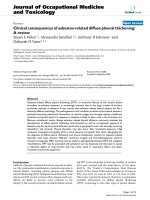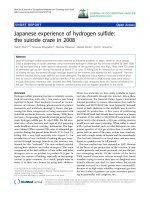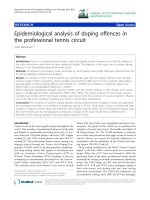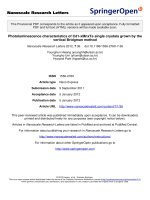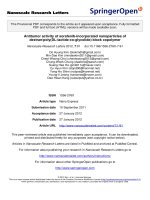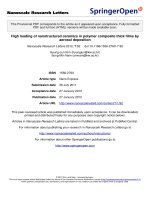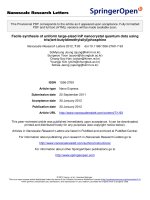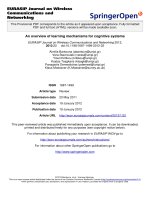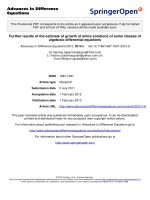Báo cáo toán học: " Structure-property relations of co-doped bismuth layer-structured Bi3.25La0.75(Ti1-xMox)3O12 ceramics" pptx
Bạn đang xem bản rút gọn của tài liệu. Xem và tải ngay bản đầy đủ của tài liệu tại đây (1.81 MB, 15 trang )
This Provisional PDF corresponds to the article as it appeared upon acceptance. Fully formatted
PDF and full text (HTML) versions will be made available soon.
Structure-property relations of co-doped bismuth layer-structured
Bi3.25La0.75(Ti1-xMox)3O12 ceramics
Nanoscale Research Letters 2012, 7:42 doi:10.1186/1556-276X-7-42
Pasinee Siriprapa ()
Anucha Watcharapasorn ()
Sukanda Jiansirisomboon ()
ISSN 1556-276X
Article type Nano Express
Submission date 6 September 2011
Acceptance date 5 January 2012
Publication date 5 January 2012
Article URL />This peer-reviewed article was published immediately upon acceptance. It can be downloaded,
printed and distributed freely for any purposes (see copyright notice below).
Articles in Nanoscale Research Letters are listed in PubMed and archived at PubMed Central.
For information about publishing your research in Nanoscale Research Letters go to
/>For information about other SpringerOpen publications go to
Nanoscale Research Letters
© 2012 Siriprapa et al. ; licensee Springer.
This is an open access article distributed under the terms of the Creative Commons Attribution License ( />which permits unrestricted use, distribution, and reproduction in any medium, provided the original work is properly cited.
- 1 -
Structure-property relations of co-doped bismuth layer-structured
Bi
3.25
La
0.75
(Ti
1–x
Mo
x
)
3
O
12
ceramics
Pasinee Siriprapa
1
, Anucha Watcharapasorn
1,2
, and Sukanda Jiansirisomboon*
1,2
1
Department of Physics and Materials Science, Faculty of Science, Chiang Mai
University, Chiang Mai, 50200, Thailand
2
Materials Science Research Center, Faculty of Science, Chiang Mai University,
Chiang Mai, 50200, Thailand
*Corresponding author:
Email addresses:
PS:
AW:
SJ:
- 2 -
Abstract
In this work, the fabrication and investigation of substituting higher-valence Mo
6+
for
Ti
4+
ion on the B-site of La
3+
-doped Bi
4
Ti
3
O
12
[BLT] structure to form
Bi
3.25
La
0.75
(Ti
1–x
Mo
x
)
3
O
12
[BLTM] (when x = 0, 0.01, 0.03, 0.05 0.07, 0.09, and 0.10)
ceramics were carried out. X-ray diffraction patterns of BLTM ceramics indicated an
orthorhombic structure with lattice distortion, especially with a higher concentration
of a MoO
3
dopant. Microstructural investigation showed that all ceramics composed
mainly of plate-like grains. An increase in MoO
3
doping content increased the length
and thickness of the grain but reduced the density of the ceramics. Electrical
conductivity was found to decrease, while the dielectric constant increased with Mo
6+
doping concentration. Ferroelectric properties were found to be improved with
increasing MoO
3
content and were optimized at x = 0.1.
Keywords: ceramics; X-ray diffraction; dielectric properties; microstructure;
ferroelectricity.
Background
In recent years, the family of bismuth layer-structured ferroelectrics has received
much attention as the candidate for ferroelectric random access memories. An
extensively studied bismuth titanate (Bi
4
Ti
3
O
12
[BIT]) is a member of the Aurivillius
family that can be represented by a general formula (Bi
2
O
3
)[A
m–1
(B)
m
O
3m+1
] which
consists of (Bi
2
O
2
)
2+
sheets alternating with (Bi
2
Ti
3
O
10
)
2−
perovskite-like layers [1].
BIT has large spontaneous polarization along the a axis ( approximately 50 µC/cm
2
),
low processing temperature, high Curie temperature, and is a Pb-free material [2].
However, it still has high leakage current and domain pinning due to defects, such as
Bi vacancies accompanied by oxygen vacancies [3-4]. To overcome these problems,
A-site substitution by a replacement of volatile Bi with rare earth or other metal oxide
additives is often necessary for ferroelectric property improvement. For example, ions
of La [5], V [6], Nd [7], and Pr [8] have been used to substitute the Bi ion in a BIT
bulk material or thin film without destroying its layered structure. Bu et al. [9]
prepared La-doped BIT thin films by pulsed laser deposition and reported that these
films were appropriate for non-volatile random access memory devices because of
their high remanent polarization and low leakage current. In recent years, SimÕes et
al. [10] reported that a doping content of x = 0.75 in Bi
4–x
La
x
Ti
3
O
12
[BLT] showed an
improvement of the fatigue endurance upon a repeated cyclic electric field which
emphasized its possible use in FRAM applications. However, these BLT ceramics still
showed a rather high leakage current. Attention has thus been paid to investigate this
material in order to overcome this disadvantage. Wang et al. [11] reported that
substitution of high-valence ions, such as Mo
6+
, in BLT thin films or known as Mo
6+
co-doped BLT thin films led to polarization fatigue improvement, high remanent
polarization, and lower leakage current density.
In terms of ceramics, there has been no detailed study on a new co-doped
bismuth-layered structure based on Mo
6+
-doped Bi
3.25
La
0.75
Ti
3
O
12
. In this study,
therefore, effects of MoO
3
doping concentration on the phase, microstructure, and
electrical properties (i.e., conductivity, dielectric, and ferroelectric properties) of BLT
ceramics produced by a conventional solid-state mixed-oxide method are reported and
discussed.
- 3 -
Methods
A perovskite bismuth-layered structure based on Bi
3.25
La
0.75
(Ti
1–x
Mo
x
)
3
O
12
[BLTM]
(x = 0, 0.01, 0.03, 0.05, 0.07, 0.09, and 0.10) powders was prepared using a solid-state
mixed-oxide method. Starting binary oxide powders, i.e., Bi
2
O
3
(>98%, Fluka; Sigma-
Aldrich Corporation, St. Louis, MO, USA), La
2
O
3
(99.98%, Fluka), TiO
2
(>99%,
Riedel-de Haën; Sigma-Aldrich Corporation, St. Louis, MO, USA), and MoO
3
(99.9%, Fluka), were ball-milled and calcined at 750°C for 4 h. The slurry was
transferred to a spherical flask and placed in a shell freezer. The flask was rotated in
an ethanol bath for at least 1 h. The flask of frozen slurry was then immediately
transferred to a vacuum dryer and dried for 24 h. After the ice was sublimated, fine
dried powder was produced. The BLTM powders were then pressed under a uniaxial
hydraulic pressure of 5.5 MPa with a few drops of 3 wt.% polyvinyl alcohol used as a
binder. The pressed samples were sintered at temperatures in a range of 1,000 to
1,150°C for 4 h. Optimum sintering temperature for producing highest-density
ceramics was determined, and the samples were selected for further characterization.
Phases of selected ceramics were characterized using an X-ray diffractometer [XRD]
(X-pert, PANalytical B.V., Almelo, The Netherlands) with CuKα radiation. Density
was measured by Archimedes' method. The ceramics were polished and thermally
etched at a temperature of 150°C below the optimum sintering temperature for 15 min
dwell time prior to microstructural investigation using a scanning electron microscope
[SEM] (JEOL JSM-6335F, JEOL Ltd., Akishima, Tokyo, Japan). Average grain size
was determined using a mean linear intercept method from SEM micrographs.
Electrical conductivity measurement was done at 1 kHz using an LCZ meter.
Dielectric constant [
ε
r
] and loss tangent [tan
δ
] were measured at room temperature
with a frequency between 1 to 100 kHz using LCR Hitester 3532-50 (Hioki, Ueda,
Nagano, Japan). Ferroelectric hysteresis polarization-electric field [P-E] loops were
determined using a computer-controlled modified Sawyer-Tower circuit. Remanent
polarization [P
r
], maximum polarization [P
max
], coercive field [E
c
], maximum field
[E
max
], and loop squareness [R
sq
] values were evaluated from the loops.
Results and discussion
X-ray diffraction patterns of BLTM calcined powders with various MoO
3
doping
concentration are shown in Figure 1. The patterns were well matched with the ICSD
No. 150091 database of Bi
3.25
La
0.75
Ti
3
O
12
, which indicated an existence of a single
orthorhombic phase without a detectable second phase. The densification data of
BLTM ceramics sintered at various temperatures between 1,000 to 1,150°C (not
shown here) indicated that the optimum sintering condition for achieving maximum
density was 1,100°C and 4 h dwell time. These ceramic samples were selected for
phase characterization whose results are shown in Figure 2. All XRD patterns
basically indicated an orthorhombic structure similar to those found in the powders. It
could be seen from the XRD patterns of samples with high MoO
3
doping content
(≥0.05 mol) that X-ray intensities of a particular set of planes, i.e., (004), (006), (008),
(0012), (0014), and (0016), were relatively higher than those in the samples with
lower MoO
3
content. This suggested that the preferred orientation of BLT crystallites
was increased due to Mo
6+
ions.
Density and grain size measured in terms of grain length are presented in Table
1. Increasing MoO
3
doping content was found to reduce density values. Typical
morphologies of polished and thermally etched surfaces of BLTM ceramics are shown
in Figure 3. All samples showed plate-like morphology with variation in grain size
- 4 -
and orientation. It was obvious that both grain length and thickness gradually
increased with increasing MoO
3
content. It was also recognized that MoO
3
played an
important role in increasing anisotropies of the surface and grain boundary energies
and mobilities [12, 13]. The sample containing MoO
3
≥ 0.05 mol showed grains
which tended to stack and align in the same direction. For those containing a smaller
amount of MoO
3
(≤0.03 mol), their grains became smaller with a more randomized
grain orientation. This observation corresponded well to the XRD result (Figure 1b)
where the preferred orientation of (00l)-type planes occurred in BLTM ceramics with
high MoO
3
concentration.
The electrical conductivity of BLT and BLTM ceramics measured at
frequencies of 1, 50, and 100 kHz is shown in Figure 4. The conductivity values of
BLTM were lower than those of undoped BLT ceramic regardless of measurement
frequency. This seemed to be the effect of the donor dopant on the electrical
conductivity of a p-type material in which electrons were introduced when Mo
6+
substituted at Ti
4+
site compensating holes present in the sample [14]. According to
previous studies on vanadium-doped BIT [6] and niobium-doped BIT [14], oxygen
vacancies [
o
V ] could similarly be reduced by Mo
+6
substitution for Ti
+4
site in BLT
ceramics. For BLT, electrical conductivity at low frequencies, i.e., 1 and 50 kHz, was
much lower than that at 100 kHz. This could be explained by the contributions of
space-charge polarization at the grain boundary and ionic polarization caused by ionic
motion [15-17]. It has been reported that a low-frequency conductivity response was
dominated by the grain boundary, while a high-frequency conductivity response was
dominated by ferroelectric crystalline layers inside the grains. Hence, it could be
speculated that the low-frequency dependence was dominated by an interacting
charge carrier system, which was similar to an ionic conductor. For BLTM ceramics,
the apparent decrease in frequency dependence of alternating current [AC]
conductivity seemed to correspond well to an increase in grain size which in turn
reduced the amount of grain boundaries. Among BLTM samples whose average grain
size was about the same, these ceramics therefore showed similar frequency
dependence and magnitude of AC conductivity.
Room temperature
ε
r
and dielectric tan
δ
of the BLTM ceramics are shown in
Figure 5, and the values are listed in Table 1. It was experimentally observed that the
dielectric constant gradually increased from 127 for BLT to a maximum of 414 for
0.03 mol MoO
3
doping content. An increase in dielectric constant of BLTM was
expected to be caused by partial substitution of Mo
6+
ion for Ti
4+
ions in the B-site
which implied that the MoO
3
dopant reduced space charges or ionic conduction and
resulted in a low leakage current which, in turn, resulted in an enhanced dielectric
constant. A further increase in MoO
3
content over 0.03 mol was found to decrease the
dielectric constant, possibly due to overcompensation of charge which caused a slight
increase in electrical conductivity.
Ferroelectric P-E hysteresis loops of MoO
3
-doped BLT ceramics were measured
at room temperature with an applied field of 60 kV/cm and a frequency of 50 Hz as
shown in Figure 6. For undoped BLT, no hysteresis behavior was observed. It was
previously reported by Zhang et al. [17] that an electric field as high as 530 kV/cm
was required to pole a BLT thin film at room temperature. In addition, Kim et al. [18]
showed that hysteresis behavior was observed when the polarization was carried out
using an applied field of approximately 60 kV/cm at 50°C. Therefore, it seemed that a
- 5 -
relatively high leakage current as seen from its high electrical conduction was the
main reason for the non-hysteresis behavior observed in the BLT ceramic. Remanent
polarization and coercive field were found to increase after Mo
6+
was doped into BLT
ceramics which were similar to a previous investigation on Nb-doped BLT ceramics
[18]. Because of the temperature and field dependence of ferroelectric properties, i.e.,
remanent polarization and coercive field of ceramics [19-20], these parameters were
normalized in a form of P
r
/P
max
and E
c
/E
max
values, where P
max
was the polarization
value at the E
max
. These ratios are listed in Table 1 along with the values of R
sq
. It
seemed that Mo
6+
substituting for Ti
4+
in the BLT ceramic efficiently decreased the
concentration of
O
V
, which weakened the influence of domain pinning on
polarization [21]. A decrease of space charge (
O
V
) density as well as electrical
conductivity thus led to the large remanent polarization observed. In addition, changes
in domain structures may be one of the factors affecting the coercive field [14]. As
can be seen from the figure, the BLTM ceramic with a Mo doping concentration of
0.1 mol showed a well defined P-E hysteresis loop and better squareness than BLT
and other BLTM ceramics. This research thus suggested that the partial substitution of
Mo
6+
for Ti
4+
ions at the B-site could improve ferroelectric properties of BLT
ceramics with an optimum ferroelectric behavior obtained at x = 0.1 mol.
Conclusions
A new system of co-doped bismuth titanate-layered structure ceramics, i.e.,
Bi
3.25
La
0.75
(Ti
1–x
Mo
x
)
3
O
12
or BLTM (x = 0, 0.01, 0.03, 0.05, 0.07, 0.09, and 0.10), was
successfully prepared by a solid-state mixed-oxide method. X-ray diffraction analysis
indicated that the MoO
3
dopant induced a preferred orientation of the BLT ceramics
with changes in lattice constant of its orthorhombic structure. Grain size was found to
increase with increasing MoO
3
doping content. Electrical conductivity of BLTM was
slightly decreased by Mo
6+
donor doping due to the charge compensation between the
provided excess electrons and inherent holes. This led, consequently, to an increased
dielectric constant from 127 for BLT to a maximum of 414 for 0.03 mol MoO
3
doping
content. Addition of MoO
3
content also increased the remanent polarization of over
10 µC/cm
2
, and this value was shown to be much larger than that of the BLT ceramic,
due to a reduction of domain pinning oxygen vacancies and leakage current loss with
optimum ferroelectric properties obtained for the composition of x = 0.1 mol. It is
suggested that molybdenum-doped BLT could be an alternative material for potential
applications in electronic industries which require a lead-free material having large
remanent polarization and lower processing temperatures.
Competing interests
The authors declare that they have no competing interests
Authors' contributions
PS carried out the BLTM ferroelectric ceramic experiments, analysis, and writing of
the manuscript. AW and SJ participated in the conception and design of the study and
revised the manuscript for important intellectual content. All authors read and
approved the final version of the manuscript.
Acknowledgments
This work is financially supported by the Thailand Research Fund (TRF) and the
Nation Research University Project under Thailand's Office of the Higher Education
- 6 -
Commission (OHEC). PS would like to thank the Commission on Higher Education
for their support through a grant fund under the program Strategic Scholarships for
Frontier Research Network for the Ph.D. Program Thai Doctoral degree, Faculty of
Science and Graduate School, Chiang Mai University for this research.
References
1. Aurivillius B: Mixed bismuth oxides with layer lattices: II. structure of
Bi
4
Ti
3
O
12
. Arkiv Kemi 1949, 1:499-512.
2. Yao YY, Song CH, Bao P, Su D, Lu XM, Zhu JS, Wang YN: Doping effect
on the dielectric property in bismuth titanate. J Appl Phys 2004, 95:3126-
3130.
3. Lohkamper R, Neumann H, Arlt G: Internal bias in acceptor-doped BaTiO
3
ceramics: numerical evaluation of increase and decrease. J Appl Phys
1990, 68:4220-4227.
4. Stewart WC, Cosentino LS: Some optical and electrical switching
characteristics of a lead zirconate titanate ferroelectric ceramic.
Ferroelectrics 1970, 1:149-167.
5. Park BH, Kang BS, Bu SD, Noh TW, Lee JH, Jo WK: Lanthanum-
substituted bismuth titanate for use in non-volatile memories. Nature
1999, 401:682-684.
6. Noguchi Y, Miyayama M: Large remanent of polarization of vanadium-
doped Bi
4
Ti
3
O
12
. Appl Phys Lett 2001, 78:1903-1905.
7. Kojima T, Sakai T, Watanabe T, Funakubo H, Saito K, Osada M, Large
remanent polarization of (Bi,Nd)
4
Ti
3
O
12
epitaxial thin films grown by
metalorganic chemical vapor deposition. Appl Phys Lett 2002, 80:2746-
2478.
8. Chen M, Liu ZL, Wang YJ, Wang CC, Yang XS, Yao KL: Ferroelectric
properties of Pr
6
O
11
-doped Bi
4
Ti
3
O
12
. Solid State Commun 2004, 130:735-
739.
9. Bu SD, Kang BS, Park BH, Noh TW: Composition dependence of the
ferroelectric properties of lanthanum-modified bismuth titanate thin
films grown by using pulsed-laser deposition. J Korean Phys Soc 2000,
36:L9-L12.
10. SimÕes AZ, Quinelato C, Ries A, Stojanovic BD, Longo E, Varela JA:
Preparation of lanthanum doped Bi
4
Ti
3
O
12
ceramics by the polymeric
precursor method. Mater Chem Phys 2006, 98:481-485.
11. Wang X, Ishiwara H: Polarization enhancement and coercive field
reduction in W- and Mo-doped Bi
3.35
La
0.75
Ti
3
O
12
thin film. Appl Phys Lett
2003, 82:2479-2481.
12. Horn DS, Messing GL: Anisotropic grain growth in TiO
2
-doped alumina.
Mater Sci Eng A 1995, 195:196-205.
13. Powers JD, Glaeser AM, In: German RM, Messing GL, Cornwall RG (Eds.):
Sintering Technology. Marcel Dekker Press, New York 1996.
14. Zhang L, Chu R, Zhao S, Li G, Yin Q: Microstructure and electrical
properties of niobium doped Bi
4
Ti
3
O
12
layer-structured piezoelectric
ceramic. Mater Sci Eng B 2005, 116:99-103.
15. Shulman HS, Damjanovic D, Setter N: Niobium doping and dielectric
anomalies in bismuth titanate: J Am Ceram Soc 2000, 83:528-532.
16. Kim JS: Effects of Nb on dielectric and ferroelectric properties of bismuth
titanate ceramics. Integr Ferroelectr 2006, 79:139-145.
- 7 -
17. Zhang ST, Yuan GL, Wang J, Chen YF, Cheng GX, Liu ZG: Temperature-
dependent effect of oxygen vacancy on polarization switching of
ferroelectric Bi
3.25
La
0.75
Ti
3
O
12
thin films. Solid State Commun 2004,
132:315-318.
18. Kim JS, Ahn CW, Lee HJ, Kim IW, Jin BM: Nb doping effects on
ferroelectric and electrical properties of ferroelectric Bi
3.25
La
0.75
(Ti
1 -
x
Nb
x
)
3
O
12
ceramics. Ceram Int 2004, 30:1459.
19. Ye Z, Tang MH, Cheng CP, Zhou YC, Zheng XJ, Hu ZS: Simulation of
polarization and butterfly hysteresis loops in bismuth layer-structured
ferroelectric thin films. J Appl Phys 2006, 100:094101-1-094101-5.
20. Burkhanov AI, Shilnikov AV, Sopit AV, Luchaninov AG: Dielectric and
electromechanical properties of (1 – x)PMN–xPZT ferroelectric ceramics.
Phys Solid State 2000, 42:936-943.
21. Baudry L: Theoretical investigation of the influence of space charges on
ferroelectric properties of PbZrTiO
3
thin film capacitor. J Appl Phys 1999,
86:1096-1105.
Figure 1. X-ray diffraction patterns of BLTM powder. All powders were
examined in a 2
θ
range of 10° to 80° and calcined at 750°C.
Figure 2. X-ray diffraction patterns of BLTM ceramics. All ceramics were
examined in a 2
θ
range of 10° to 80° and sintered at 1,100°C.
Figure 3. SEM micrographs of Bi
3.25
La
0.75
(Ti
1–x
Mo
x
)
3
O
12
ceramics. (a-g) indicated
x = 0, 0.01, 0.03, 0.05, 0.07, 0.09, and 0.10, respectively.
Figure 4. Relationship between electrical conductivity and MoO
3
content of
Bi
3.25
La
0.75
(Ti
1–x
Mo
x
)
3
O
12
ceramics. The measurement was done at
frequencies of 1, 50, and 100 kHz.
Figure 5. Relationship between dielectric constant and MoO
3
content of
Bi
3.25
La
0.75
(Ti
1–x
Mo
x
)
3
O
12
ceramics. The measurement was done at
frequencies of 1, 50, and 100 kHz. The inset shows dielectric loss tangent
as a function of MoO
3
content.
Figure 6. Relationship between P-E hysteresis loops and MoO
3
content of
Bi
3.25
La
0.75
(Ti
1–x
Mo
x
)
3
O
12
ceramics. The measurement was done at a
frequency of 50 Hz for BLTM ceramics sintered at 1,100°C.
- 8 -
Table 1. Physical, dielectric, and ferroelectric properties of Bi
3.25
La
0.75
(Ti
1–
x
Mo
x
)
3
O
12
ceramics
Dielectric
properties
a
Ferroelectric properties
Mo
content
(mol)
Density
(g·cm
−3
)
Grain
length
(µm)
ε
εε
ε
r
tan
δ
δδ
δ
P
r
/P
max
E
c
/E
max
R
sq
0
7.46 ± 0.03
2.59 ± 0.61
127 0.001
0.05 0.05 0.06
0.01
7.21 ± 0.01
2.66 ± 0.79
124 0.007
0.23 0.23 0.25
0.03
7.16 ± 0.03
4.61 ± 2.13
414 0.551
0.96 0.69 1.15
0.05
6.74 ± 0.02
5.94 ± 2.11
402 0.519
0.74 0.58 0.84
0.07
6.94 ± 0.02
7.73 ± 3.13
387 0.510
0.78 0.70 1.04
0.09
6.79 ± 0.01
8.04 ± 3.31
310 0.461
0.81 0.71 1.06
0.10
6.83 ± 0.02
8.13 ± 2.97
308 0.349
0.96 0.57 1.15
a
Measurement was carried out at room temperature and at a frequency 1 kHz.
ε
r
,
dielectric constant; tan
δ
, loss tangent; P
r
, remanent polarization; P
max
, maximum
polarization; E
c
,
coercive field; E
max
, maximum field; R
sq
, loop squareness.
Figure 1
Figure 2
Figure 5
Figure 6
